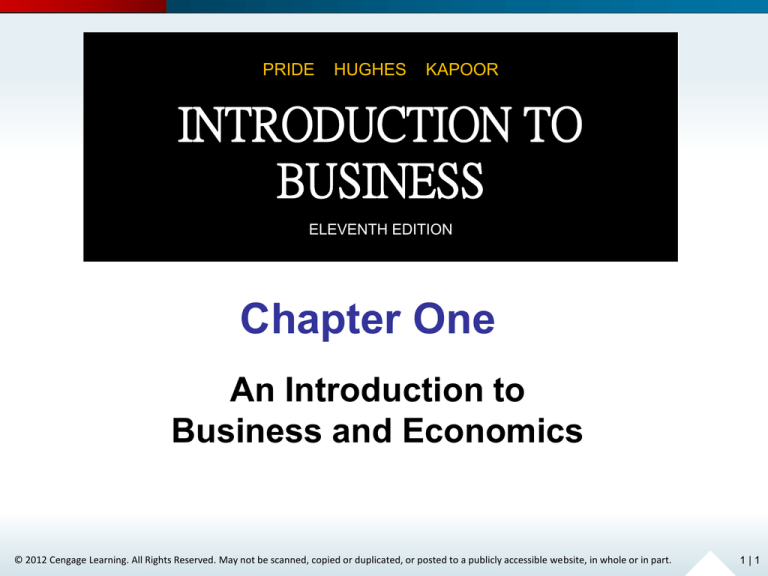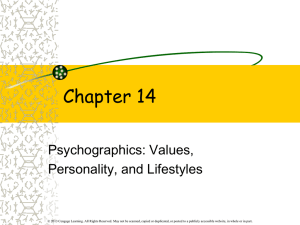
PRIDE
HUGHES
KAPOOR
INTRODUCTION TO
BUSINESS
ELEVENTH EDITION
Chapter One
An Introduction to
Business and Economics
© 2012 Cengage Learning. All Rights Reserved. May not be scanned, copied or duplicated, or posted to a publicly accessible website, in whole or in part.
1|1
Learning Objectives
1. Discuss what you must do to be successful in the world
of business
2. Define business and identify potential risks and
rewards
3. Define economics and describe two types of economic
systems: capitalism and command economy
4. Identify the ways to measure economic performance
5. Outline the four types of competition
6. Summarize the factors that affect the business
environment and the challenges that American
businesses will encounter in the future
© 2012 Cengage Learning. All Rights Reserved. May not be scanned, copied or duplicated, or posted to a publicly accessible website, in whole or in part.
1|2
Tips for Studying Business
Prepare before you go to class
2. Read the chapter
3. Underline or highlight important concepts
4. Take notes
5. Apply the concepts
6. Practice critical thinking
7. Prepare for exams
• These study outlines will help
1.
© 2012 Cengage Learning. All Rights Reserved. May not be scanned, copied or duplicated, or posted to a publicly accessible website, in whole or in part.
1|3
Key Terms and Ideas
Define Free Enterprise
Know the definition of Business
• Understand why studying business is
important
What are the four resources that businesses
combine in order to be successful?
Know the difference between Manufacturing
Businesses and Service Businesses
What are Marketing Intermediaries and why
are they important?
© 2012 Cengage Learning. All Rights Reserved. May not be scanned, copied or duplicated, or posted to a publicly accessible website, in whole or in part.
1|4
Satisfying Needs
Why do people buy goods and services?
What must businesses understand about
customer needs to help them be
successful?
© 2012 Cengage Learning. All Rights Reserved. May not be scanned, copied or duplicated, or posted to a publicly accessible website, in whole or in part.
1|5
Sales Revenue and Profit
What is Profit?
• How is it calculated?
Know the purposes of profit
Who/What are Stakeholders?
• Know the difference between primary and
secondary stakeholders
© 2012 Cengage Learning. All Rights Reserved. May not be scanned, copied or duplicated, or posted to a publicly accessible website, in whole or in part.
1|6
Types of Economic Systems
Be able to define and explain
• Economics
• Microeconomics
• Macroeconomics
• Economy
• Factors of Product
• Entrepreneur
© 2012 Cengage Learning. All Rights Reserved. May not be scanned, copied or duplicated, or posted to a publicly accessible website, in whole or in part.
1|7
Differences in Economic Systems
List and define principle characteristics of the
major economic systems
How do these systems differ?
What are the four basic economic questions that
economic systems seek to address?
© 2012 Cengage Learning. All Rights Reserved. May not be scanned, copied or duplicated, or posted to a publicly accessible website, in whole or in part.
1|8
Capitalism
How is Capitalism defined?
What does Adam Smith’s laissez-faire capitalism
have to do with modern capitalism?
What are the basic assumptions and principal
tenets of Smith’s laissez-faire capitalism?
© 2012 Cengage Learning. All Rights Reserved. May not be scanned, copied or duplicated, or posted to a publicly accessible website, in whole or in part.
1|9
Capitalism (cont’d)
What are distinguishing characteristics of
capitalism in the United States?
What role do the following groups play in a U.S.style capitalist system?
• Households
• Businesses
• Governments
© 2012 Cengage Learning. All Rights Reserved. May not be scanned, copied or duplicated, or posted to a publicly accessible website, in whole or in part.
1 | 10
Types of Economic Systems
Define Command Economies
• What are the two major command
economies?
• What are their key characteristics?
• How do the two command economies differ?
© 2012 Cengage Learning. All Rights Reserved. May not be scanned, copied or duplicated, or posted to a publicly accessible website, in whole or in part.
1 | 11
Measuring Economic Performance
Define Productivity
What are major economic indicators of
productivity?
• How are they calculated?
• What do they tell us about the economy?
© 2012 Cengage Learning. All Rights Reserved. May not be scanned, copied or duplicated, or posted to a publicly accessible website, in whole or in part.
1 | 12
Economic Performance: Key Terms
Be able to define and explain the significance of
• Gross Domestic Product (GDP)
• Inflation
• Deflation
• Unemployment Rate
• Consumer Price Index (CPI)
• Producer Price Index (PPI)
© 2012 Cengage Learning. All Rights Reserved. May not be scanned, copied or duplicated, or posted to a publicly accessible website, in whole or in part.
1 | 13
Evaluating a Nation’s Economic Health
Why is it important to occasionally evaluate a
nation’s economic health?
Be able to define the following terms and explain
what they tell us about economic health
•
•
•
•
•
•
•
Balance of Trade
Bank Credit
Corporate Profits
Inflation Rate
National Income
New Housing Starts
Prime Interest Rate
© 2012 Cengage Learning. All Rights Reserved. May not be scanned, copied or duplicated, or posted to a publicly accessible website, in whole or in part.
1 | 14
The Business Cycle
What is The Business Cycle?
Define Recession and Depression
What are Monetary Policies?
• What role does the Federal Reserve play in the
United States’ monetary policies?
Be able to define
• Fiscal Policy
• Federal Deficit
• National Debt
© 2012 Cengage Learning. All Rights Reserved. May not be scanned, copied or duplicated, or posted to a publicly accessible website, in whole or in part.
1 | 15
Types of Competition
What is Competition?
• Know the different types of competition
Be able to define
• Perfect (or Pure) Competition
- Supply
- Demand
- Equilibrium (Market) Price
- Where does the equilibrium price occur on the supply
and demand curves?
• Monopolistic Competition
- What can firms do to gain a competitive advantage
in a monopolistic competition situation?
© 2012 Cengage Learning. All Rights Reserved. May not be scanned, copied or duplicated, or posted to a publicly accessible website, in whole or in part.
1 | 16
Types of Competition (cont’d)
Define and identify key characteristics of the
following types of competition
• Oligopoly
• Monopoly
- Know the difference between
- Natural Monopoly and
- Legal (Limited) Monopoly
© 2012 Cengage Learning. All Rights Reserved. May not be scanned, copied or duplicated, or posted to a publicly accessible website, in whole or in part.
1 | 17
American Business Today
What is a Standard of Living?
• How is it measured?
Know the basic stages of business development
in the United States
Explain the differences between the four stages
of early business development
•
•
•
•
Barter system
Domestic system
Factory system
Specialization
© 2012 Cengage Learning. All Rights Reserved. May not be scanned, copied or duplicated, or posted to a publicly accessible website, in whole or in part.
1 | 18
American Business Today (cont’d)
Know the key characteristics of business
development in the 1900s
• How did industries change?
• Major economic events that shaped business
development and economic policy.
• Changes in the late 20th century and early 21st
century that altered standards of living and
consumption patterns.
• What is E-business and how has it changed
businesses?
© 2012 Cengage Learning. All Rights Reserved. May not be scanned, copied or duplicated, or posted to a publicly accessible website, in whole or in part.
1 | 19
American Business Today (cont’d)
What are the defining issues and innovations of
the 21st century so far?
• The role played by technology
• Service businesses
Why are many pessimistic about the U.S.’s
future economic prosperity?
Be able to discuss the Current Business
Environment
© 2012 Cengage Learning. All Rights Reserved. May not be scanned, copied or duplicated, or posted to a publicly accessible website, in whole or in part.
1 | 20
The Challenges Ahead
There are many challenges for business ahead
Be able to discuss some of the challenges outlined in the
textbook
• Economic stability
• Jobs for the unemployed
• Regulation of the financial and banking industries
• Reducing the national debt while stimulating business
growth
• Maintaining U.S. competitiveness in a globalized
business environment
• Conserving natural resources and the natural
environment
• Changing demographics
• Cultural diversity
• Terrorism and extremism
© 2012 Cengage Learning. All Rights Reserved. May not be scanned, copied or duplicated, or posted to a publicly accessible website, in whole or in part.
1 | 21







